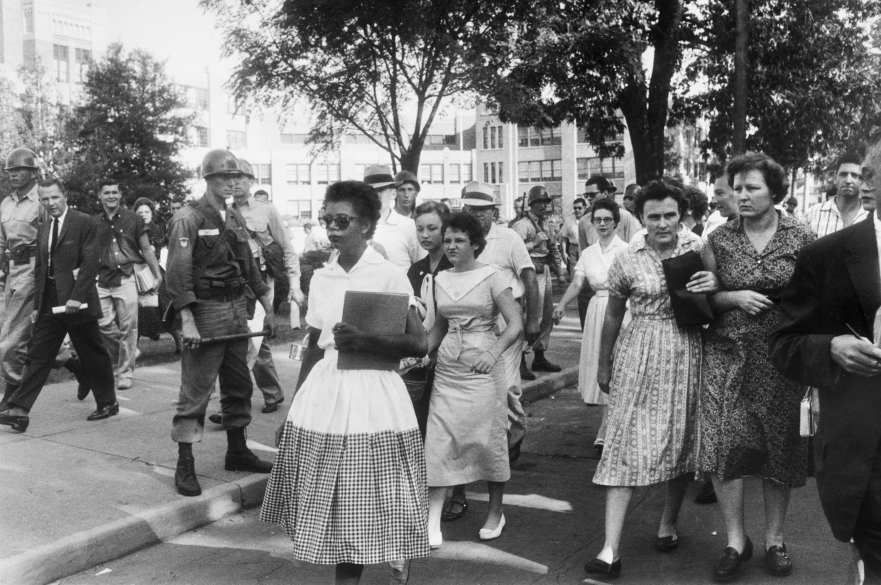Montgomery and Mass Protest
Printed Page 829
Section Chronology
What set the civil rights movement of the 1950s and 1960s apart from earlier acts of black protest was its widespread presence in the South, the large number of people involved, their willingness to confront white institutions directly, and the use of nonviolent protest and civil disobedience to bring about change. The Congress of Racial Equality and other groups had experimented with these tactics in the 1940s, organizing to integrate movie theaters, restaurants, and swimming pools in northern cities. In the South, the first sustained protest to claim national attention began in Montgomery, Alabama, on December 1, 1955.

CHAPTER LOCATOR
What was Eisenhower’s “middle way” on domestic issues?
How did Eisenhower’s foreign policy differ from Truman’s?
What fueled the prosperity of the 1950s?
How did prosperity affect American society and culture?
How did African Americans fight for civil rights in the 1950s?
Conclusion: What unmet challenges did peace and prosperity mask?
 LearningCurve
LearningCurve
Check what you know.
That day, police arrested Rosa Parks for violating a local segregation ordinance. Riding a crowded bus home from work, she refused to give up her seat so that a white man could sit down. The bus driver called the police, who promptly arrested her. Parks had long been active in the local NAACP, headed by E. D. Nixon. They had already talked about challenging bus segregation. So had the Women’s Political Council (WPC), led by Jo Ann Robinson, an English professor at Alabama State, who had once been humiliated by a bus driver when she accidentally sat in the white section.
When word came that Parks would fight her arrest, WPC leaders mobilized teachers and students to distribute fliers urging blacks to boycott the buses. E. D. Nixon called a mass meeting at a black church, where those assembled founded the Montgomery Improvement Association (MIA). The MIA arranged volunteer car pools and marshaled more than 90 percent of the black community to sustain the yearlong Montgomery bus boycott.
Montgomery bus boycott
 Yearlong boycott of Montgomery’s segregated bus system in 1955–1956 by the city’s African American population. The boycott brought Martin Luther King Jr. to national prominence and ended in victory when the Supreme Court declared segregated transportation unconstitutional.
Yearlong boycott of Montgomery’s segregated bus system in 1955–1956 by the city’s African American population. The boycott brought Martin Luther King Jr. to national prominence and ended in victory when the Supreme Court declared segregated transportation unconstitutional.
Elected to head the MIA was twenty-six-year-old Martin Luther King Jr., a young Baptist pastor with a doctorate in theology from Boston University. King addressed mass meetings at churches throughout the bus boycott, inspiring blacks’ courage and commitment by linking racial justice to Christianity. He promised, “If you will protest courageously and yet with dignity and Christian love … historians will have to pause and say, ‘There lived a great people — a black people — who injected a new meaning and dignity into the veins of civilization.’”
Montgomery blacks summoned their courage and determination in abundance. An older woman insisted, “I’m not walking for myself, I’m walking for my children and my grandchildren.” Boycotters walked miles or carpooled to get to work, contributed their meager financial resources, and stood up to intimidation and police harassment. Authorities arrested several leaders, and whites firebombed King’s house. Yet the movement persisted until November 1956, when the Supreme Court declared unconstitutional Alabama’s laws requiring bus segregation. King’s face on the cover of Time magazine in February 1957 marked his rapid rise to national and international fame. In January, black clergy from across the South had chosen King to head the Southern Christian Leadership Conference (SCLC), newly established to coordinate local protests against segregation and disfranchisement. The prominence of King and other ministers obscured the substantial numbers and critical importance of black women in the movement. King’s fame and the media’s focus on the South also hid the national scope of racial injustice and the struggles for racial equality in the North that both encouraged and benefited from the black freedom struggle in the South.
QUICK REVIEW